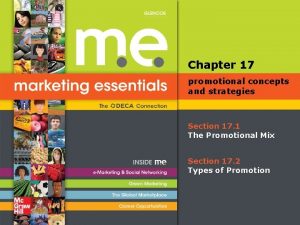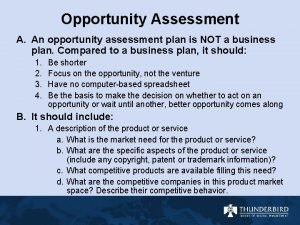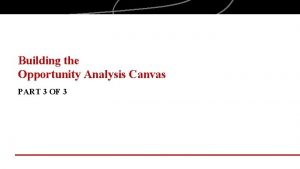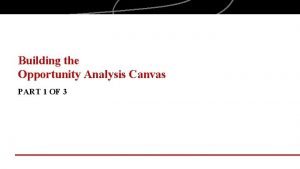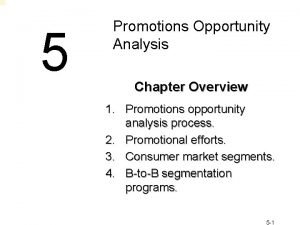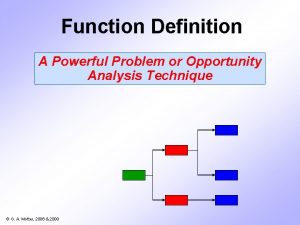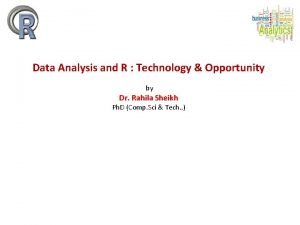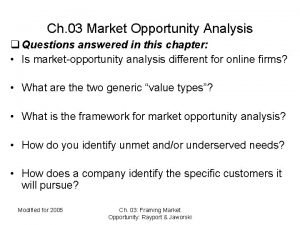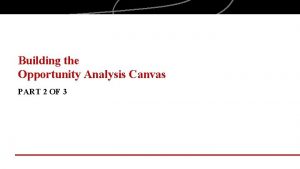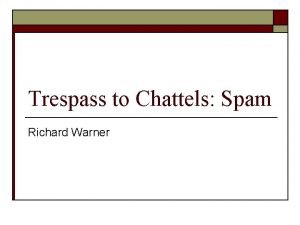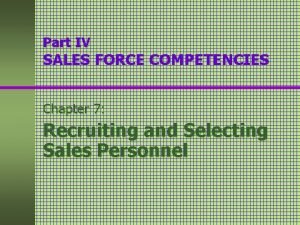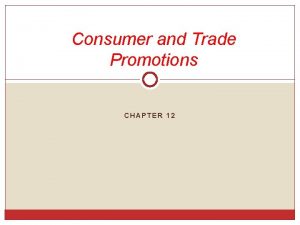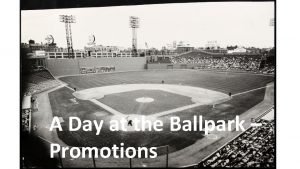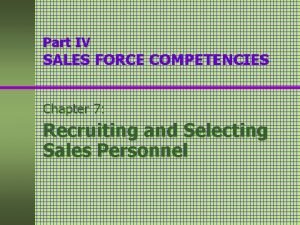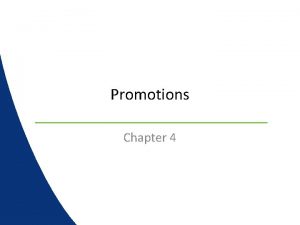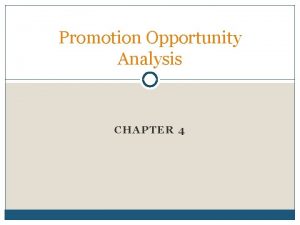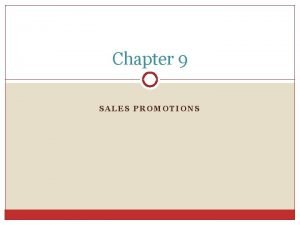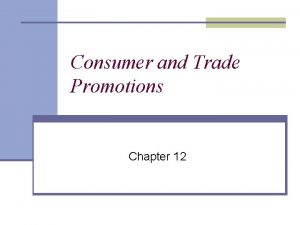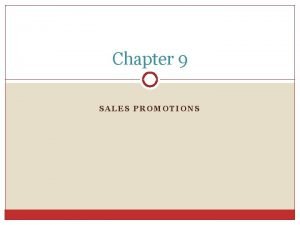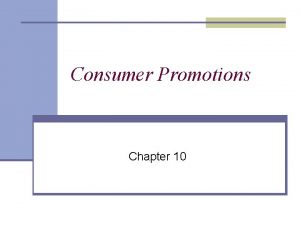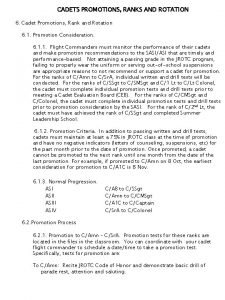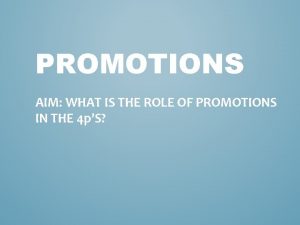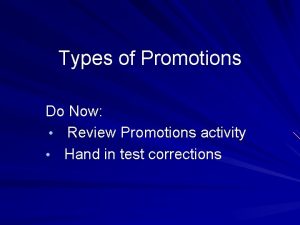5 Promotions Opportunity Analysis Chapter Overview 1 Promotions
























- Slides: 24

5 Promotions Opportunity Analysis Chapter Overview 1. Promotions opportunity analysis process. 2. Promotional efforts. 3. Consumer market segments. 4. B-to-B segmentation programs. 5 -1

The Marketing Plan Promotion Opportunity Analysis (marketers identify target audience) Five Steps 1) Conduct a communication market analysis. 2) Establish objectives. 3) Create a budget. 4) Prepare a promotional strategy. 5) Match tactics with strategy. 5 -2

Promotions Opportunity Analysis Step 1 Conduct a Communications. Market Analysis • • • Competitive analysis Opportunity analysis Target market analysis Customer analysis Positioning analysis 5 -3

Competitive Analysis • Identifies major competitors. • Identifies communication strategies and tactics of each competitor. Sources of information • Secondary data • Other people • Primary research 5 -4

Opportunity Analysis (reveals communication opportunities that can be exploited) • Are there customers that the competition is ignoring? • Which markets are heavily saturated? • Are the benefits of our products being clearly articulated? • Are there opportunities to build relationships using a slightly different marketing approach? • Are there opportunities that are not being pursued? 5 -5

Target Market Analysis • What benefits does each target market want from the product? • How can each target market be reached? • What appeal works best for each target market? • What needs of the target market are not being met by a competing firm? • What is the demographic and psychographic makeup of each target market? 5 -6

Customer Analysis Three Types of Customers • Current company customers. • The competitors’ customers. • Potential customers who currently do not purchase the product but may become interested. 5 -7

Positioning Analysis • Positioning is the perception created in the consumers mind regarding the nature of the company and its products relative to the competition. • Positioning is created by factors such as product quality, prices, distribution, image and marketing communications. 5 -8

Product Positioning Strategies § Attributes § Competitors § Use or application § Price/quality § Product user § Product class § Cultural symbol 4 -9

Promotions Opportunity Analysis Step 2 Establish Communication Objectives Possible Objectives: • Develop brand awareness • Increase good/service category demand • Change customer beliefs or attitudes. • Enhance purchase actions • Encourage repeat purchases • Build customer traffic • Enhance firm image • Increase market share • Increase sales • Reinforce purchase decisions 5 -10

Promotions Opportunity Analysis Step 3 Establish a Communications Budget • Budgets based on • communication objectives • marketing objectives • Budgets vary from consumer to B-to. B markets • Unrealistic assumption to assume direct relationship between advertising and sales. Copyright © 2010 Pearson Education, Inc. publishing as Prentice Hall 4 -11

Factors Impacting Relationship Between Promotions and Sales • • • The goal of the promotion Threshold effects Carryover effects Wear-out effects Decay effects Random events Copyright © 2010 Pearson Education, Inc. publishing as Prentice Hall 4 -12

FIGURE 5. 5 A Decay Effects Model Copyright © 2010 Pearson Education, Inc. publishing as Prentice Hall 4 -13

FIGURE 5. 6 Methods of Determining Marketing Communication Budgets • • • Percentage of sales Meet-the-competition “What we can afford” Objective and task Payout planning Quantitative models Copyright © 2010 Pearson Education, Inc. publishing as Prentice Hall 4 -14

Promotions Opportunity Analysis Step 4 Prepare a Promotional Strategy • Communication strategies are broad, long-term guidelines for the marketing communications program. • Should be linked to opportunities and threats identified by the communication market analysis. • Should fit with the company’s overall message, image and themes. 5 -15

Promotions Opportunity Analysis Step 5 Match Tactics with Strategies Tactics support the communication strategies. Examples of tactics would include: • Specific advertisements. • Personal selling enticements for sales reps. • Sales promotions such as coupons, premiums, sweepstakes, and contests. • Special product packages and labels. • Price changes. • Trade discounts to retailers. 5 -16

Advantages to Segmenting Markets Market segmentation – dividing the marketing into smaller homogeneous groups • Helps identify company strengths and weaknesses. • Identifies the best set of customers. • Clarifies marketing objectives associated with specific target markets. • Allows for more precise communications budgeting. • Links firm’s strategies and tactics to a specific target group 5 -17

Tests to Determine if a Particular Market Segment Is Viable Ø The individuals or businesses within the segment are homogeneous. Ø The market segment is different from the population as a whole and distinct from other market segments (heterogeneous). Ø The market segment is large enough to be financially viable to target with a separate marketing campaign (substantial). Ø The market segment must be reachable through some type of media or marketing communications method (operational). 4 -18

FIGURE 5. 8 Methods of Segmenting Consumer Markets • Demographics • Psychographics • Generations • Geographic • Geodemographics • Benefits • Usage Copyright © 2010 Pearson Education, Inc. publishing as Prentice Hall 4 -19

VALS 2 Psychographic Segmentation • • Innovators – successful, sophisticated – upscale products. Thinkers – educated, conservative, practical – durability, value. Achievers – goal-oriented, conservative, career, and family Experiencers – young, enthusiastic, impulsive, fashion, social Believers – conservative, conventional, traditional Strivers – trendy, fun-loving, peers important Makers – self-sufficient, respect authority, not materialistic Survivors – safety, security, focus on needs, price Copyright © 2010 Pearson Education, Inc. publishing as Prentice Hall 4 -20

Psychographics and Technology Psychographic Segmentation • New Enthusiasts – cutting edge, eager, high incomes/education • • Hopefuls – cutting edge, lack financial means Faithful – not eager, but not averse Oldliners – not interested in new technologies Independents – higher incomes, but do not value new technology • Surfers – ambivalent about new technology, cynical about business Copyright © 2010 Pearson Education, Inc. publishing as Prentice Hall 4 -21

Table 4. 1 Characteristics of Generation Segments Copyright © 2010 Pearson Education, Inc. publishing as Prentice Hall 4 -22

Geodemographic Segmentation • Combines • Demographic census data • Geographic information • Psychographic information • PRIZM • 62 market segments • Southside City • Towns and Gowns Copyright © 2010 Pearson Education, Inc. publishing as Prentice Hall 4 -23

FIGURE 5. 11 Methods of Segmenting B-to-B Markets • NAICS/SIC code • Type of business • Size of business • Geographic location • Product usage • Purchase decision process • Customer value 5 -24
 Promotional concept
Promotional concept An opportunity assessment plan is
An opportunity assessment plan is Using effective promotions
Using effective promotions Chapter 1 overview of financial statement analysis
Chapter 1 overview of financial statement analysis Promotion opportunity analysis
Promotion opportunity analysis Global market opportunity analysis
Global market opportunity analysis Factors involved in opportunity analysis canvas
Factors involved in opportunity analysis canvas Opportunity canvas
Opportunity canvas Promotion opportunity analysis
Promotion opportunity analysis Opportunity analysis is one of the basic functions of
Opportunity analysis is one of the basic functions of Technology opportunity analysis
Technology opportunity analysis Market opportunity analysis framework
Market opportunity analysis framework Opportunity analysis canvas
Opportunity analysis canvas Role of imc
Role of imc Business promotions
Business promotions Compuserve v cyber promotions
Compuserve v cyber promotions Crystal executive isagenix map
Crystal executive isagenix map Promotion personal selling
Promotion personal selling Nnn promotions interview questions
Nnn promotions interview questions Cross ruff sampling
Cross ruff sampling Grandstand managers day
Grandstand managers day Randolph brooks austin texas
Randolph brooks austin texas Business promotions
Business promotions Nnn promotions interview questions
Nnn promotions interview questions Business promotions
Business promotions
